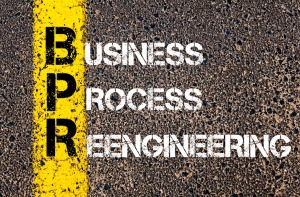Execute business process re-engineering to detail organisational processes with RACI, empowerment, escalation and exception matrix.
Our goal is to help organisations to improve quality, productivity, profits, and reduce wastage. Using the framework of Total Quality Management / ISO 9001, we create a business management system that covers Organization structure; delineation of roles & responsibilities; map and draft the business process so that these operate as an effective system.
The Prashna Approach
More About Business Process Re-engineering
Business Process Re-engineering Methodology is a management approach used to identify areas for improvement, remove barriers to communication, and streamline business processes.
What is business process re-engineering?
Business process re-engineering (BPR) is redesigning processes that have failed to produce desired results through changes made to the existing structure. For example, BPR may involve changing how information flows among different departments, changing the technology infrastructure, or introducing new systems. In addition, processes often change over time due to technological advances, increased competition from other businesses, and changes in consumer preferences.

Business Process Re-engineering Methodology (BPRM) is a management approach used to identify areas for improvement, remove barriers to communication, and streamline business processes. The need for Business Process Re-engineering Methodology is to increase effectiveness and reduce costs. BPRM is based on the philosophy that successful businesses are made up of effective teams working together toward a common objective.
Business process re-engineering steps
Business process re-engineering is a project management approach for optimising and automating business processes. The goal is to identify which processes need improvement or automation. BPR is usually done using a combination of interviews with key stakeholders, surveys and other qualitative methods such as focus groups. The idea behind BPR is to increase efficiency while reducing costs.
Business process re-engineering model
A Business Process Reengineering Model (BPRM) is a management tool used to help organisations identify and implement improvements in their work. BPRMs use a framework with three major parts:
- Identifying processes that need improvement.
- Analysing the current state of those processes.
- Designing new processes for the future.
The goal is to redesign company operations to be more efficient.
Steps involved in the implementation of business process re-engineering
The first thing you need to do when implementing BPR is to gather information about your current processes. This step includes analysing your current practices, identifying new ones, and discussing them with your stakeholders and customers. Once you have collected all relevant data, you should design a new system for your company. You may choose from the various tools to help you create your new system. Next, implement the new system and evaluate how well it works. Next, make any needed changes based on what you learn from your evaluations. Finally, share your findings with your team and your customers.
Business process re-engineering approach
Business Process Re-engineering (BPR) is a strategic project management methodology based on understanding and improving existing processes through collaboration between line managers, IT staff, and business analysts. The BPR approach starts with a comprehensive analysis and definition of current business processes. This step is followed by a process redesign phase where the new processes are developed. Finally, the actual implementation phase brings about the change from old systems to the new ones.
Business process re-engineering strategy
A business process re-engineering (BPR) strategy is designed to help businesses effectively use technology to streamline processes, reduce costs, increase efficiency, and save time and resources. In addition, business Process Re-engineering needs to solve organisational issues such as customer service delays, poor quality, product defects, employee turnover, and high staff costs.
How are business process re-engineering and change management related?
Business Process Reengineering (BPR) is often confused with Change Management, which focuses on planning for a future state. BPR is about achieving a specific goal by altering the way things are done now, whereas Change Management is about ensuring that a new solution supports the long term goals of the company. The difference between these concepts is that BPR is reactive, while Change Management is proactive.
6 R's of business process re-engineering
Business process reengineering is a set of activities that aim to reduce costs, improve quality, enhance customer satisfaction, increase productivity, and make processes more flexible. The six R's include: Reduce Costs - This includes things like outsourcing, reduction in headcounts, automation, etc. Improve Quality - This includes everything from implementing a new product design to ensuring the website works better for customers. Enhance Customer Satisfaction - This is about increasing customer retention and keeping customers coming back. Increase Productivity - This means having a higher output volume with fewer resources. Make Processes Flexible - This means adapting to changing market conditions and adjusting to the customer's needs.
